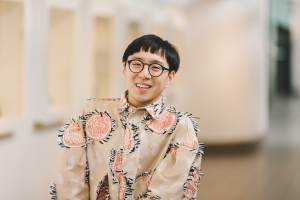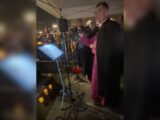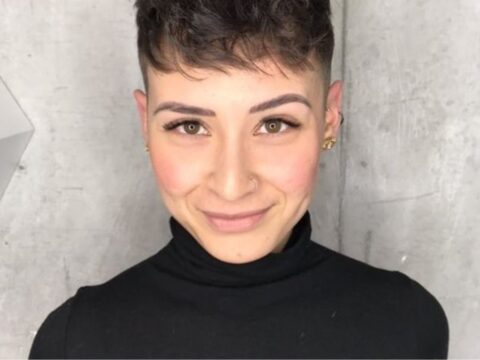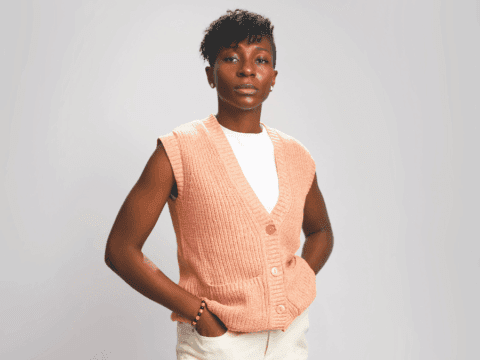Behind the brick walls of the 401 Richmond art hub in Toronto, a small gallery space is a gathering ground for disabled and deaf people. At around a thousand square feet, Tangled Art Gallery supports a diverse community of artists and art lovers alike.
When I visit last March, a video of a sign-language interpreter plays at the gallery’s entrance, introducing guests to the exhibition Object Sensations. Inside, interactive paintings and sculptures are mounted on white walls, while tactile installations bring sounds to life for visitors. I place my hand on a sculpture made of speakers and feel the vibrations against my skin. Comfortable lounge seats are amply placed throughout the gallery, so those who need to rest feel safe to do so.
You may unsubscribe from any of our newsletters at any time.
“I think a lot of people really resonate with our space,” says Sean Lee, an artist and director of programming at Tangled. “We are trying to tell multiple stories of disability.”
Tangled is the only permanent gallery in Canada dedicated to disability art. Its mandate is to exhibit artists who identify as dis- abled and to foster a space that centres what Lee and others call “crip culture.” Not all art pieces are explicitly about disability, just “informed by that lived experience,” says Lee.

Tangled traces its roots to a 2003 exhibition that launched the Abilities Art Festival. Ten years later, the non-profit rebranded as Tangled Art + Disability, with the gallery opening in 2016. The organization marked another milestone the following year when it became fully disability-led.
For Eliza Chandler, the gallery’s founding artistic director, the name “Tangled” speaks to how she and fellow disabled people exist together in ways they can’t untangle. She describes Tangled as a “meeting space for a diverse understanding of our relationships with disability.” The gallery has hosted over 30 exhibitions since 2016, typically showcasing five artists a year.
Olivia Brouwer, an interdisciplinary and partially blind artist from Cambridge, Ont., has been working with Tangled for some time. She started creating art to become more comfortable with her disability. When she visited other galleries, she rarely came across braille or audio art descriptions that would make the work accessible to her. “I think it’s a shame that galleries would assume that blind people would never come to visit,” she says. “It’s an assumption that if you can’t see the art, you can’t appreciate it, but that’s not true at all.”
More on Broadview:
Brouwer’s art is tactile and incorporates audio, requiring participants to experience it through senses other than sight. “It’s kind of interesting to challenge the status quo of gallery behaviour,” she says. Her 2023 Tangled exhi- bition, The Scales That Fall from Our Eyes, featured recorded con- versations with people in the non-seeing community. She says she created the project so the sighted can make connections with those who are not.
Salima Punjani is a Montreal artist who is working with Tangled for her September exhibition, There Is Always Something Better. Using multi-sensory media such as vibrotactile technology, which creates physical sensations through sound, the show explores themes of contentment and critical thinking about the wellness industry.
Punjani’s previous Tangled exhibition in 2018 also involved vibrotactile technology. She recorded the brainwaves of people with multiple sclerosis (MS) while asking them what it’s like to be perceived as disabled. “I wanted to create a work that allowed people to express how they would like to be seen,” says Punjani, who also has MS. “We told our stories.” Visitors could listen to the stories and simultaneously feel the vibrations of the tellers’ brainwaves — a reminder that disabled people are human. “We’re not just medical data,” she says. “We have to listen to each other.”
Punjani appreciates working in disability art spaces like Tangled. “There aren’t those hierarchies of art. Like it doesn’t make my art less valuable if it’s touchable,” she says.
Non-disabled patrons who visit Tangled are often hesitant at first to engage with the pieces, since touching is off-limits in most galleries. But once that initial caution is overcome, many enjoy being able to interact with the art. “People learn something new about themselves,” says Lee.
Above all, though, Lee and Chandler want those in the disabled community to feel a sense of belonging at Tangled, whether they are an artist or a visitor. Each detail of the gallery space was designed with intention — it is a love letter to the crip community and reminds them that they are not an afterthought.
The world is filled with representations of disability “that often don’t match up with our experience of disability,” says Chandler. “But here, we can all exist tangled together.”
***
Macenzie Rebelo is a journalist in Toronto.













